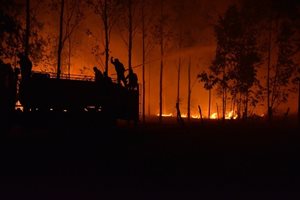(1/8/2018)
Nearly a month after the Thomas Fire started, California families and businesses remain on edge as the wind-whipped fires and smoke consume their communities. Already, the fires have destroyed at least 1,024 structures and damaged 250 more, reported CBS. "We are still on guard," fire information officer Rudy Evenson told CBS. "It's been a very unpredictable fire and we just don't know what these winds are going to do."
At times like this, communities look to healthcare facilities for healing, relief and recovery. And yet, many healthcare facilities don’t have an effective disaster response, leaning on community and government resources for their own recovery. This is unacceptable if we want our facilities to remain safe healing environments when our communities need us the most.

Scott Cormier, Medxcel FM’s Vice President of Emergency Management, Environment of Care and Safety, advises
six considerations for healthcare facilities facing a wildfire disaster.
- Do you have staff members who live in affected areas? If so, it may be wise for them to evacuate early to avoid a last-minute move.
- As fires spread, smoke and soot can clog air filters in your facility and create a dangerous environment to patients. Have extra air filters on hand, as well as masks and respirators.
- Road closures can make it difficult for staff, patients, supplies and emergency crews to reach your facility. Map out alternate routes, or consider alternate transportation.
- Wildfires spread quickly, but evacuations take time. Ensure you are basing decisions on the most up-to-date information. If necessary, evacuate with enough time to avoid delays or unforeseen obstacles from derailing your efforts.
- Do you have enough supplies for burn victims? While you might typically transfer burn patients to specialty centers, those may not be available due to surge or transportation issues. Make sure you have enough supplies and up-to-date training for clinical staff so they can care for burn patients properly. Telemedicine consults with burn specialists can be helpful when you can’t transfer critical patients immediately.
- Plan for remediation before the fires are over. Have emergency response teams on-site to expedite resolution.
Natural disasters are rising in frequency and intensity, says FEMA, and may require resources beyond what local and state authorities can provide. We can’t have healthcare facilities draining community resources. Next time a disaster strikes your community, ensure your facility can help lead relief efforts, remaining a source of healing to the community you serve.